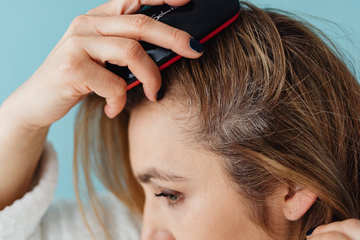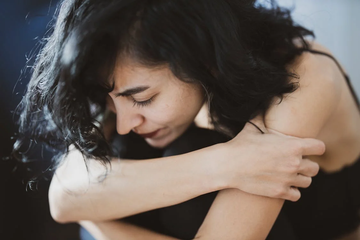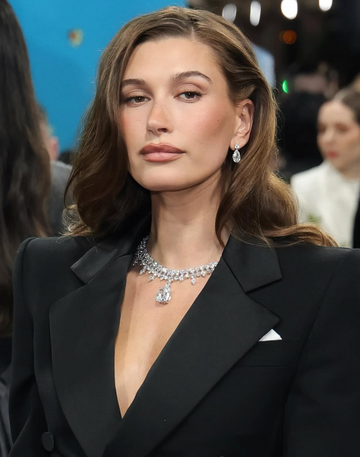It’s not just hot flashes. Your strands are feeling the heat, too…
You’re showering like usual when you glance down and see it: a clump of hair that definitely wasn’t there yesterday. Or maybe it’s your part suddenly looking… wider. More strands in your brush. Less bounce in your ponytail. And somewhere in the back of your mind, the question forms. “Wait—is this menopause?”
The short answer is yes. Menopausal hair loss is very real—and very common. It happens to millions of women, but (surprise!) no one really talks about it. The hormonal changes that come with menopause can directly affect your hair’s growth cycle, thickness, and texture.
Below, we’re breaking down what’s going on (hormones, aging, stress—oh my), how to spot the signs, and what you can do about it. From treatment options to volume-boosting cuts and TYME styling hacks, we’ve got you covered—roots to ends.
Menopause and hair loss 101
Let’s talk hormones—specifically, what’s happening behind the scenes when menopause kicks in and why your hair might start to behave... differently.
As estrogen and progesterone levels begin to drop, the hair growth cycle shifts. These hormones are responsible for keeping strands in the anagen phase (aka the growth phase) longer. When they decline, that growth window shortens. Hair sheds sooner and takes longer to grow back, resulting in fewer active follicles at any given time.
At the same time, androgens—testosterone and its byproducts—can become more prominent. These hormones are linked to the miniaturization of hair follicles, which means new strands can grow back finer, shorter, and weaker over time.
This combination—less growth, more shedding, and smaller follicles—is the biological foundation of menopause hair loss. It doesn’t happen overnight, but it’s very real, and it’s driven by internal changes you can’t control.
To make things more complex, these hormonal shifts can also make hair feel drier, coarser, or more prone to breakage—even if shedding isn't dramatic. The scalp may also produce less oil, which can affect how your hair looks and feels from day to day.
But the thing is, just because the cause is hormonal doesn’t mean you’re out of options. Understanding how menopause and hair loss are connected is the first step to approaching it with intention, not frustration. Once you know the “why,” it becomes a lot easier to figure out your next “what now.”
What menopausal hair loss looks like
Hair loss due to menopause doesn’t usually look like what we’ve been taught to fear. It’s not dramatic overnight shedding or sudden bald patches (thankfully). It’s slow, sneaky, and often subtle—until it’s not.
Here’s how it typically shows up.
A widening part
That middle or side part you’ve had forever? It might start looking a little more... spacious. You’ll probably notice it most under bright lights or in selfies.
Less density at the crown
The top of your head may feel thinner to the touch or look flatter in photos. Less lift, more scalp. Styling starts to feel harder—even when you're doing everything “right.”
Diffuse thinning overall
Instead of patchy loss, you’ll probably notice a gradual, all-over decrease in volume. Ponytails feel smaller. Top knots don’t quite hold like they used to.
Texture changes
Hair can become more brittle, dry, or wiry. What once was soft and sleek may feel rougher, frizzier, or less cooperative—even when your routine hasn’t changed.
Shedding in the brush or shower
You might notice more strands coming out when you style or wash—especially during brushing or detangling. It’s not alarming all at once, but it adds up.
Quick myth-buster✗ Myth: You’ll wake up one day with half your hair gone. ✔ Reality: Most menopausal hair loss is slow and manageable. It’s often more about noticing a change in fullness or bounce than anything drastic. |
Noticing these signs doesn’t mean you’re out of options. It just means your hair needs a little extra strategy—and maybe a new approach to your cut, care, or styling routine.
Other factors that worsen menopausal hair loss
While hormones are the main driver, they’re not working alone. For many, menopause hair loss is less about one cause and more about a combo of small stressors adding up—creating the perfect storm for thinning hair.
Here’s what can quietly amplify the issue.
– Stress
High cortisol levels can disrupt your hair’s natural growth cycle, pushing more strands into the shedding phase. Chronic stress can also tighten blood vessels, limiting the nutrients your follicles receive.
– Poor nutrition
A lack of iron, protein, B vitamins, or essential fatty acids can weaken hair from the inside out. Crash dieting or skipping meals can speed up shedding without you even realizing it.
– Thyroid conditions
An underactive thyroid (common during midlife) can mimic or worsen hormonal hair thinning. It often goes undiagnosed, but hair loss, fatigue, and dry skin can be red flags.
– Medications
Antidepressants, blood pressure meds, cholesterol drugs, and even some hormone therapies may list hair thinning as a side effect. It’s worth checking labels and asking your doctor.
– Hair habits
Years of bleach, heat styling, tight buns, or ignoring your scalp’s needs can make already-fragile strands even more vulnerable. The scalp ages too—and needs just as much TLC.
The good news? All of these factors are manageable. Once you know what’s adding fuel to the fire, you can start to make changes that support your scalp health, reduce breakage, and protect what you’ve got. Small shifts add up.
What you can do about it
Dealing with menopausal hair loss isn’t about chasing miracle cures. It’s about building a plan that supports your hair from the inside and the outside so you can feel more like yourself again.
Medical options (that are backed by science)
Minoxidil (Rogaine)
This FDA-approved topical treatment helps extend the growth phase of hair and can boost density over time. It’s one of the most proven options for treating hair loss due to menopause—just know it requires consistency (think months, not weeks).
Hormone Replacement Therapy (HRT)
For some, balancing estrogen levels through HRT can help slow down hormonal hair thinning. It’s not a first-line solution for everyone, but if you’re exploring HRT for other menopausal symptoms, it could be a double win. Always talk to your doctor first.
Iron and biotin
Low iron is a sneaky cause of hair thinning, especially if you’ve had heavy periods during perimenopause. Biotin gets a lot of hype, but it only helps if you’re deficient. Get bloodwork before investing in a supplement drawer.
Lifestyle shifts that support healthy hair
– Manage stress with movement, meditation, or simply better boundaries.
– Eat balanced meals with enough protein, healthy fats, and key vitamins.
– Sleep like it’s your job—rest is when your body (and hair) recovers.
– Move gently and consistently, even just taking 20-minute walks, to boost circulation and hormone regulation.
None of these changes will transform your hair overnight, but they can create a stronger, healthier foundation over time. You need to play the long game: a steady shift toward balance, nourishment, and support. Be it you’re easing into menopause or fully in it, the goal isn’t perfection—it’s progress.
Styling + haircut hacks to fake fullness
Is your hair looking a little thinner? You don’t need extensions or a full rebrand; you just need a haircut that plays to your strengths and styling tricks that bring the lift.
Start with the cut. Some of the best haircuts for thinning hair include.
– Blunt bobs and lobs: Blunt ends create visual density and keep your hair from looking wispy or frayed.
– Soft layers: When placed strategically, they add movement without sacrificing fullness.
– Face-framing shapes or curtain bangs: They draw the eye up and away from sparse spots at the crown or part line.
Hair styling tools can help take that fresh cut and make it work harder. A blow-dry brush, for example, gives you built-in root lift and bounce while smoothing frizz in one pass. For lived-in volume or a quick refresh, the TYME Iron Pro adds bend and body without flattening your strands. Just bend, shake, and you’re out the door.
Pro tip: Don’t underestimate the power of a part switch. A deep side part adds asymmetry and instant lift where you need it most. Or try adding a light, wispy fringe to shift focus from a widening part to your eyes or cheekbones.
And if you’re skipping wash day? Dry shampoo and volumizing powder are your ride-or-dies. They add grip, lift, and texture, which is especially useful if your hair tends to fall flat after blow-drying.
Bottom line: menopause and hair loss might shift your texture, but the right haircut and tools can help you reclaim control—and maybe even find a new favorite style in the process.
When to talk to a doctor or specialist
While menopausal hair loss is common, not all hair loss should be brushed off as “just hormones.” Sometimes, your hair’s telling you something more.
Here are signs it’s time to check in with a pro.
– Sudden, rapid shedding that feels extreme or distressing
– Bald patches or circular areas of loss (not typical for menopause)
– Scalp irritation, redness, or flaking
– Eyebrow or eyelash thinning, along with scalp hair changes
These could point to conditions like alopecia areata, thyroid dysfunction, or iron deficiency—issues a dermatologist or endocrinologist can help pinpoint and treat.
So… does menopause cause hair loss? Yes—but if the pattern or speed of loss feels off, don’t wait. Hair is a clue, not a diagnosis. Trust your instincts and advocate for answers.
The emotional side of hair loss
Let’s just say it: hair loss feels personal. If your hair has been part of your identity—your style, your confidence, your signature—you’re not overreacting. This is emotional territory, and it’s totally valid to feel frustrated, self-conscious, or even a little lost.
But here’s what’s also true: your hair doesn’t define your beauty. You don’t lose who you are when you lose a bit of volume. What you’re going through is real, but so is your ability to adapt, redefine, and feel amazing with the hair you do have.
If you’re feeling alone in this, know you’re not. There are entire communities of women navigating hair loss due to menopause and sharing what’s working, what’s hard, and what’s helping them feel like themselves again. Lean into that. Talk to your stylist. Talk to friends. Be gentle with yourself.
Hair might shift, but your confidence doesn’t have to. You’ve got options, support, and a whole new chapter of style waiting.
Life with beautiful locks isn’t over
Yes, menopausal hair loss is real, but so are your options. Hair changes during this phase are normal, but they don’t have to derail your confidence. With the right knowledge, tools, and a little styling strategy, you can work with what you’ve got and still feel like you.
Your hair might evolve as you age—but so can your approach, your cut, your routine, and your mindset. If you’re ready to take the next step, explore the LifeTYME blog and their pro-grade tools to style thinner hair with more confidence, less stress, and a whole lot more volume.





